2) National Satellite Ocean Application Service (NSOAS), Beijing 100081, China
Satellite altimetry has become an important component of the global ocean observation system. In recent decades, radar altimeters have provided sufficient measurement data for marine research (Hamlington et al., 2012; Cazenave et al., 2018). The accuracy of altimeter measurements has increased to the order of centimeters because the TOPEX/ POSEIDON (T/P) altimeter improved precision orbit determination technology, providing the capability to measure global sea elevation accurately (Salameh et al., 2018). As a continuation of the T/P mission, the Jason series altimeters have consistently performed exceptionally well over the past two decades. The resolution and accuracy of global sea elevation measurements are further improved by synthetic aperture radar (SAR) altimeters (such as Sentinel-3), which introduce aperture synthesis technology in the alongtrack direction (Quartly et al., 2017; Yang et al., 2019). Conventional and SAR altimeters provide observations of nadir points along the satellite ground track, and these altimeters can be collectively referred to as nadir altimeters. Nadir altimeters play an important role in global largescale and long-term sea surface height observations, providing important data for global oceanic changes and largescale ocean circulation processes. However, nadir altimeters have small-diameter footprints, and the spacing between adjacent orbits is remarkably large. Even if a series of nadir altimeters is used to form a constellation, fusion data have difficulty describing the mesoscale and submeso-scale processes comprehensively, playing a critical role in marine activities (Fu and Ubelmann, 2014).
A wide-swath altimeter based on interferometric SAR measurements substantially improves the measurement range and spatial resolution, making mesoscale and submesoscale ocean observations possible. The surface water and ocean topography (SWOT) mission is a wide-swath altimeter project that is being jointly developed through international cooperation. Sea surface and terrestrial water heights will be observed over a 120 km wide-swath when the project is launched in 2022 (Durand et al., 2010; Desai, 2018). Gaultier et al. (2016) developed an SWOT simulator software to research the measurement performance and error impacts of this project because the launching of the SWOT mission is still pending. Research on fine-scale ocean dynamic processes has been unprecedented due to the combination of this software and the current high-resolution ocean circulation models or data assimilation (Wang and Fu, 2019; Wang et al., 2019). Furthermore, the SWOT simulator can be used to assess the error budget of the mission through error power spectrum estimation (Ubelmann et al., 2018).
Wide-swath interferometry is remarkably sensitive to changes in flight attitude. Therefore, baseline roll error (referred to as roll error) and baseline length error (referred to as length error) are important error sources for a wide-swath altimeter. The baseline error in this study represents the difference between the baseline parameters used in sea surface inversion and their true values, that is, the residual error after spaceborne calibration. Ensuring the absolute stability of the flight platform is almost impossible under current conditions. The flight attitude can be measured to a certain extent through a high-performance gyroscope and other equipment. However, considering the measurement accuracy and long-term drift, meeting the high-precision requirements of a long-term mission through this calibration alone remains difficult (Peral and Esteban-Fernandez, 2018). Fortunately, the height error caused by baseline error can be eliminated once the true baseline parameters are known. Therefore, calibration and verification based on the ground data processing phase will be indispensable.
A wide-swath altimeter calculates the sea surface height based on the interference phase, which is similar to an interferometric synthetic aperture radar (InSAR) system. Base-line parameter estimation, a crucial step in InSAR data processing, is usually conducted by classical methods, such as ground control points, interferograms, and precise orbit determination data (Du et al., 2010). However, wide-swath altimeters have the characteristics of small incident angles and short physical baselines and mainly use the dynamic ocean as the observed object. Therefore, these traditional baseline parameter estimation methods require adaptive improvements.
The first solution is to use only the values measured by the wide-swath altimeter itself. Zhang et al. (2014) proposed an attitude measurement method based on the nadir interference phase of a wide-swath altimeter system. This phase can be derived from the geometric interference relationship, in which the measurement accuracy of the nadir interferometric phase mainly depends on the change in the roll angle when the height variation of the platform or the target point is excluded. This method achieved a 1.5 arcsec accuracy in an airborne test. In addition to the nadir interference phase, Zhai et al. (2019) proposed an estimation method of the baseline roll angle for double-side looking wide-swath altimeters by using the curve intersection of the sea surface height derivative in the opposite swaths. The estimation error of this method was approximately 0.3 arcsec in the simulation experiment.
Another commonly used baseline error estimation scheme is called the cross-calibration method, which is based on the target height difference between a wide-swath altimeter and other measurement methods. In-situ measurements (Wang et al., 2018) and satellite altimeter data can provide this kind of external data. Densely distributing in situ measurement instruments in all oceans is difficult despite their high measurement accuracy. In addition, extensive altimeter data (including nadir and other wide-swath altimeters, and even the same wide-swath altimeter measurements along different tracks) can be used to estimate the baseline of a wide-swath altimeter. Fu and Rodriguez (2004) suggested that the systemic error (including roll error) could be corrected using the height difference between the ascending and descending tracks of the same target area without considering the variation of the ocean. Dibarboure et al. (2012) researched empirical cross-calibration using external references and altimetry constellations. They simulated the linear and parabolic errors, respectively, caused by the roll and length errors in different experiments. A two-step scheme joined by local estimates with different cross structures and global interpolation was performed, and this method reduced the topographic RMSE from 70 cm to 2 cm under extreme conditions. Dibarboure and Ubelmann (2014) conducted an in-depth exploration of the above methods. They evaluated the performance of the direct, collinear, crossover, and subcycle methods in correcting the SWOT roll error. They also highlighted that low-resolution uniform grid reference data have the best coverage and correction effect when using the direct method, but leakages from oceanic variability on roll easily occur. The three other methods can complement the direct method to reduce this problem.
The two above-mentioned types of error estimation methods both effectively calibrate the roll error in simulation and airborne experiments. However, these methods consider the roll error as an error source alone. The research of some wide-swath altimeter data assimilation experiments (Metref et al., 2019) revealed that length, phase, and other structural errors are also important components that should be jointly considered in future data calibration and applications. The phase error has a linear distribution characteristic similar to the roll error and can be improved to a certain extent in the processing of radar antenna electronic systems. However, the length error, which is closely related to the physical baseline, has a completely different parabolic feature; thus, it is also a source of error that should be considered. Along-track nadir altimeter data have the following advantages: remain unaffected by baseline error, high resolution along the track, create constellations from multiple nadir altimeters, and maintain stability from leakages from oceanic variability. Thus, nadir altimeters are used as an auxiliary data source to investigate the estimation and correction methods of the roll and length errors simultaneously in the same scenario. This study intends to provide a methodology that could be used the estimate the baseline error of future wide-swath altimeters.
The remainder of this paper is organized as follows. Sections 2.1 and 2.2 describe the measurement principle and the crossover calibration method, respectively. Sections 2.3 and 2.4 respectively explain the simulated wide-swath data to be corrected and the ancillary nadir track position data. Section 3 presents all results, including correction with Sentinel-3A, other single nadir altimeters, and multi-nadir altimeter constellations. Section 4 discusses the influence of different sea states on the estimation effect. Section 5 provides the conclusions.
2 Method and Data 2.1 Measurement Principle and Baseline ErrorA wide-swath altimeter can measure the sea surface height over a large scale and benefit from SAR interferometry with dual antennas. Taking SWOT mission as an example, the orbital height is approximately 890 km, and the inclination is 77.6°. The repeat period of its orbit is 21 days, and each cycle comprises 292 revolutions. The distance between adjoining tracks is approximately 130 km at the equator. Overlap between the subtracks is observed as the latitude increases, and the overlapping area becomes increasingly large. The main payload of SWOT is KaRIn, a Ka-band radar interferometer. The distance between the two antennas is 10 m (described as the baseline length), and the nominal roll angle is 0°. The ground observation swath is 60 km on the left and right (the gap is 10 km in the middle of both sides) in this design case. This measurement method enables SWOT to observe most of the world's oceans and major terrestrial waters and minimize the effects of tides on the measurement results (Esteban-Fernandez et al., 2010; Rodriguez and Esteban-Fernandez, 2010).
The principle of a wide-swath altimeter is shown in Fig.1.

|
Fig. 1 Geometric principle of wide-swath altimeter height measurements. |
In Fig.1, A1 is the primary antenna that transmits micro-wave signals to the target and receives the returned signals, while A2 is a secondary antenna that receives only the signal returned from the target. The phase difference of the echo signal according to the geometric relationship is
| $ \varphi = {\text{2}}k{r_1} - k\left({{r_1} + {r_2}} \right) \approx kB\sin \theta, $ | (1) |
where k is the wavenumber, r1 and r2 are the ranges of the two antennas to the target point, θ is the incident angle, and B is the physical baseline length. After θ is calculated by the phase difference, the height of the target point relative to the reference ellipsoid, h, can be calculated by combining the range r1 and the satellite orbit height H obtained by the precision orbit determination system:
| $ h = H - {r_1}\cos \theta . $ | (2) |
The main error sources for a wide-swath altimeter include the baseline error, phase error, orbit error, tropospheric delay, and ionospheric delay. The baseline error can be divided into roll and length errors. A strong correlation is observed between the baseline error and the crosstrack distance. Baseline errors can induce a large height error at the far end of the observation swath, which is one of the main error sources in the measurement process. The measurement principle indicates that the relationship between the baseline error and the cross-track distance can be expressed as
| $ {\text{δ }}{h_{{\text{roll}}}} = x \cdot {\text{δ }}\alpha, $ | (3) |
| $ {\text{δ }}{h_{{\text{length}}}} \approx - \frac{{{x^2} \cdot {\text{δ }}B}}{{HB}}, $ | (4) |
where x represents the cross-track distance; i.e., the distance of the target point in the cross-track direction from the nadir point. δα represents the error of the roll angle, and δB represents the error of the baseline length. The height error caused by δα linearly increases across the swath, and the height error caused by δB quadratically increases across the observation swath. These conditions indicate the production of a large height error at the far end of the swath.
For KaRIn, Eqs. (3) and (4) indicate that if a roll error of 1 arcsec exists, then the height error would be more than 30 cm at the far end of the 60 km observation swath, and the height error in that location caused by a 1 mm length error would be more than 40 cm, as shown in Fig.2.
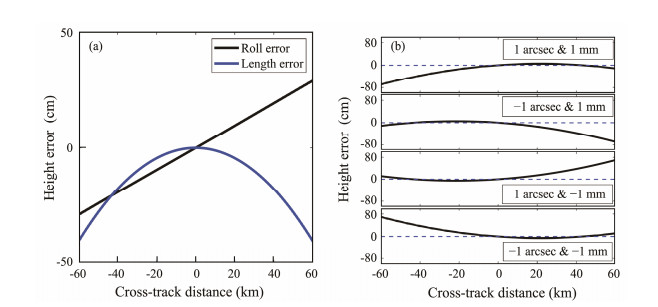
|
Fig. 2 (a) Height errors caused by a 1 mm length error and a 1 arcsec roll error (unit: cm); (b) spatial distributions of roll and length errors with different positive or negative signs (unit: cm). |
Fig.2a shows the height error caused by the 1 mm length error and the 1 arcsec roll error, and the linear and quadratic correspondence can be observed. Fig.2b shows the total height error caused by the roll and length errors with different positive and negative signs. The height error cannot be directly corrected by a simple adjustment method due to this special spatial distribution relationship. Fortunately, if the real height or accurate measurements of some points in the same measurement line are known, then the baseline error can be estimated by data matching and fitting.
2.2 Baseline Error Estimation MethodSome crossover points are generated due to their orbit shapes when wide-swath and nadir altimeters observe the same area, as shown in Fig.3.
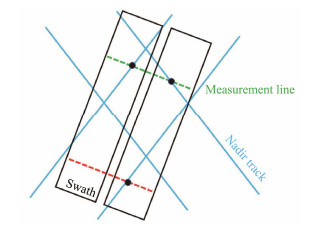
|
Fig. 3 Schematic of the crossover of wide-swath and nadir altimeters. |
The blue line in the Fig.3 represents the footprint trajectory of the nadir altimeter, the black rectangle represents the observation area of the wide-swath altimeter, and the green and red dashed lines represent the measurement lines in the cross-track direction of the wide-swath altimeter. The black dots in the figure represent crossover points of the wide-swath and nadir altimeters, which indicate the real intersection points. The wide-swath and nadir altimeters may indirectly measure the crossover point. Thus, spatial interpolation is necessary in most cases.
Spatial matching and interpolation of the sea surface height measured by the wide-swath and nadir altimeters are performed after the other error sources have been ideally corrected. The sea surface height difference at the crossover point is then calculated. Nadir altimeters are unaffected by baseline error. Thus, the difference at the crossover point can be expressed as
| $ \Delta h\left({{\text{lon}}, {\text{lat}}, t} \right) = {h_{{\text{swath}}}}\left({{\text{lon}}, {\text{lat}}, t} \right) - {h_{{\text{nadir}}}}\left({{\text{lon}}, {\text{lat}}, t'} \right) \\ = \left[ {{h_{{\text{swath}}}}\left({{\text{lon}}, {\text{lat}}, t} \right) - {h_{{\text{real}}}}\left(t \right)} \right] - \left[ {{h_{{\text{nadir}}}}\left({{\text{lon}}, {\text{lat}}, t'} \right) - {h_{{\text{real}}}}\left({t'} \right)} \right] + {\text{δ }}{h_{{\text{real}}}}\left({t - t'} \right) \\ = \left[ {x \cdot {\text{δ }}\alpha \left(t \right) + {x^2} \cdot {\text{δ }}B\left(t \right)/HB + {\varepsilon _{{\text{swath}}}}\left({{\text{lon}}, {\text{lat}}, t} \right)} \right] - {\varepsilon _{{\text{nadir}}}}\left({{\text{lon}}, {\text{lat}}, t'} \right) + {\text{δ }}{h_{{\text{real}}}}\left({t - t'} \right), $ | (5) |
where hswath, hnadir, and hreal represent the wide-swath altimeter measurements, the nadir altimeter measurements, and the real sea surface height in the target region, respectively. εswath and εnadir are the residual errors from other error sources of the wide-swath and nadir altimeters, respectively. δhreal represents the sea surface height change during their observation time.
Over the entire observation region, if more than two crossover points lie on the same measurement line (such as the green measurement line in Fig.3), then the roll and length errors can be estimated directly based on the height difference. However, if only 1 or 0 crossover point is observed in the same measurement line (as with the red measurement line in Fig.3), then obtaining the direct estimation result is impossible. The baseline error under this situation can be corrected by interpolation.
| $ P_{\text {est }}(\Delta \alpha, \Delta B)=\left(\boldsymbol{M}^{\mathrm{T}} \cdot \boldsymbol{M}\right)^{-1} \cdot \boldsymbol{M}^{\mathrm{T}} \cdot \Delta h, $ | (6) |
where Pest is the estimation of the roll and length errors. M is the orthogonal polynomial of the baseline error and the cross-track distance characteristic obtained according to Eqs. (3) and (4). Δh is the sea surface height difference at the crossover points.
2.3 Wide-Swath Radar Altimeter Simulation SystemA wide-swath radar altimeter (WSRA) simulation system is developed on the basis of the measurement principle of the wide-swath altimeter. This system mainly includes the ground point trajectory calculation, the observation swath position calculation, the error source setting, the interference phase simulated measurement, the sea surface height calculation, and the error analysis. This system is based on a wide-swath altimeter measurement geometry, which means that its source of error (roll, length, and ranging errors) is set during the measurement process rather than that directly superimposed on the sea surface height data. This phenomenon can help examine the error composition, error impact, and error estimation methods with substantial flexibility.
A random sea surface height image is used in this study as the 'target sea surface height' in the research process to simulate the wide-swath and nadir altimeters. Only the impact of various measurement errors, that is, the difference between the simulated measurement results and the target sea surface height, is considered. Therefore, the accuracy of this sea surface height image does not require verification and discussion. The target sea surface height image and the error-free sea surface height within the observation swath region are shown in Fig.4; the latter can be used as a benchmark to evaluate the estimation method below quantitatively.
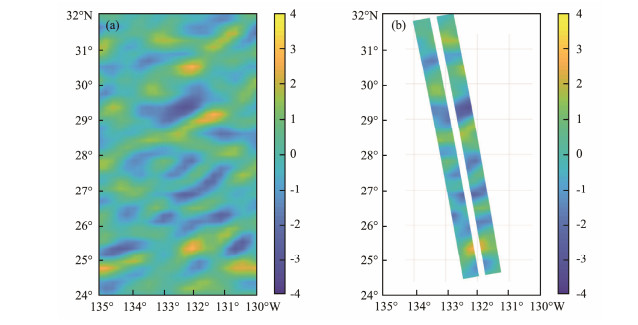
|
Fig. 4 (a), simulated sea surface height in the target region (unit: m); (b), error-free height along the swath (unit: m). |
The roll angle and the baseline length were set to the nominal value superimposed with random errors that conform to their distribution characteristics during the interference phase calculation, while only the nominal values were used in the sea surface height inversion stage. Therefore, the roll and length errors are introduced in this way. These errors are set considering the error generation and the magnitude of the actual measurement procedure to superimpose the high and low frequencies to simulate the possible flight attitude drift, baseline jitter, gyroscope error, and other possible sources of roll angle and baseline length during the measurement. The along-track distribution of the roll and length errors is shown in Fig.5. The standard deviations of the roll and length errors are 0.43 arcsec and 0.50 mm, respectively. In addition, a Gaussian random error with 0.5 cm standard deviation within the entire swath is added, which represents the residual error (refer to the discussion) of the other error sources after correction, that is, εswath in Eq. (5).
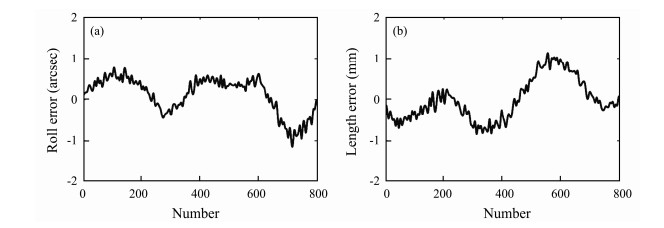
|
Fig. 5 (a), simulated along-track roll error; (b), simulated along-track length error. |
After the sea surface height calculation and error analysis, the measurement results and error distribution of the wide-swath altimeter obtained by the WSRA system under the above conditions are shown in Fig.6.
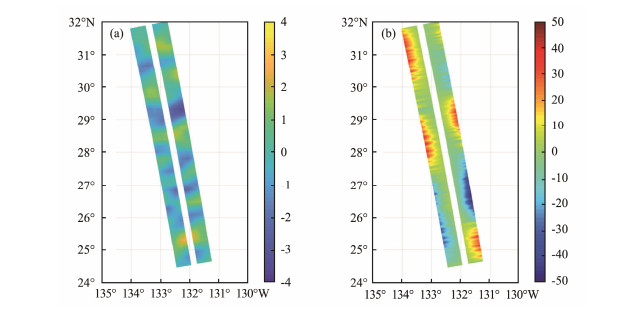
|
Fig. 6 (a), error-containing sea surface height computation (unit: m); (b), height error (unit: cm). |
A substantially large height error along the outer edge of the observed swath is found due to the influence of the baseline error. The data results show that the RMSE of the sea surface height in Fig.6 is 12.18 cm.
2.4 Parameters of Nadir AltimetersThe nadir altimeters selected in this study include Sentinel-3A, Sentinel-3B, Jason-3, Saral, and CryoSat-2. Systematic deviations will be observed between different nadir altimetry systems due to the different orbit configurations, sampling characteristics, and other measurement differences. The multi-mission cross-calibration method can be used to eliminate these deviations and derive consistent merged data (Bosch et al., 2014). Systematic deviation also exists between wide-swath and nadir altimeters for similar reasons. This bias can be approximated as a constant term over the entire observation swath considering the stability of the systematic deviation, which does not affect the estimation of the baseline error and can be eliminated during the cross-calibration process with the nadir altimeters (Ren et al., 2020).
Only the measurement point position coordinates of these nadir altimeters will be used in this study to ensure consistency with the wide-swath altimeter simulation data. The sea surface height of nadir altimeters will be generated by the WSRA system simulation, and their measurement accuracy is set to 3 cm. The relevant parameters of these altimeters are shown in Table 1.
|
|
Table 1 Parameters of nadir altimeters |
The ground track of nadir altimeters in the target region is shown in Fig.7.
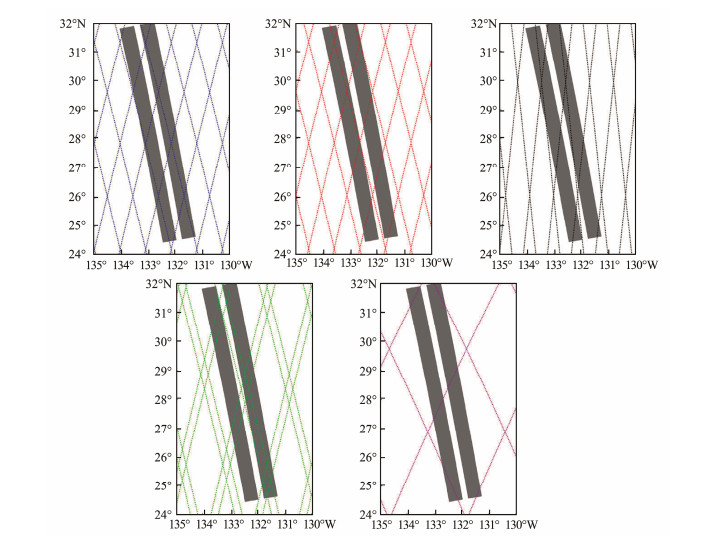
|
Fig. 7 Ground trajectory of nadir altimeters in the target region (from top left to right: Sentinel-3A, Sentinel-3B, CryoSat-2; from bottom left to right: Saral, Jason-3). |
The intersection shapes of Sentinel-3A and SWOT are the best in this region. Sentinel-3B, CryoSat-2, and Saral have a certain degree of intersection points in the observed swath, while Jason-3 only has a few crossover points with SWOT.
3 ResultsThis section will first take Sentinel-3A as an example according to the ground track relationship of the nadir and wide-swath altimeters shown in Fig.7 to conduct a comprehensive baseline error estimation step and result description. This method will be tested on other nadir altimeters and finally used in a multi-nadir altimeter constellation for baseline error estimation.
3.1 Estimation Results Based on Sentinel-3AThe ground track of Sentinel-3A in the target region is shown in Fig.7(a), and its sea surface height simulation is performed by the WSRA system, whose measurement accuracy is set to 3 cm. The result is shown in Fig.8.

|
Fig. 8 Estimated sea surface height along a Sentinel-3A swath (unit: m). |
The simulation results of Sentinel-3A are matched with the sea surface height simulated by the wide-swath altimeter shown in Fig.6(a). The precise latitude and longitude of crossover points are obtained by bilinear interpolation. The sea surface heights of Sentinel-3A and SWOT at crossover points using spatial interpolation and the height difference are calculated.
Least-squares fitting of the roll and length errors is performed by the sea surface height difference and the cross-track distance according to Eqs. (5) and (6), and their error estimation results are shown in Fig.9.
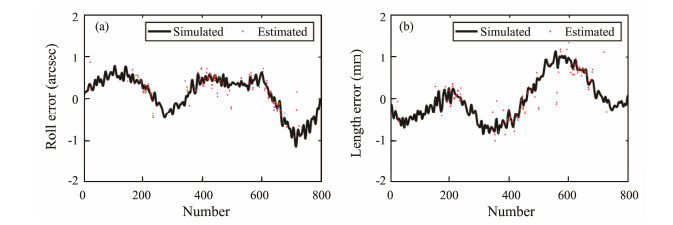
|
Fig. 9 (a), simulated and estimated values of roll error; (b), simulated and estimated values of length error. |
Fig.9 shows that the roll and length errors are well estimated on the measurement line with two or more crossover points, but these measurement lines do not cover the entire observation region. Data processing in the along-track direction is also required to achieve an overall correction of the baseline error. This step includes quartile out-lier removal, along-track spatial interpolation, and smooth noise reduction with a 50 spatial window. The roll and length error estimates after along-track processing are shown in Fig.10.

|
Fig. 10 (a), simulated and estimated values of roll error; (b), simulated and estimated values of length error. |
The data results show that the correlation coefficient between the estimated and simulated values of the roll error is 0.89 after along-track data processing, and the root mean square difference is 0.21 arcsec. Meanwhile, the correlation coefficient of the length error is 0.85, and the root mean square difference is 0.29 mm.
The sea surface height error in the entire observation swath region is calculated and corrected by using the roll and length errors according to Eqs. (3) and (4), and the corrected sea surface height and residual error images are obtained as shown in Fig.11. Statistical results show that the RMSE of the sea surface height in this image is reduced from 12.18 cm to 6.45 cm after error correction. Figs.10 and 11 respectively show that the trend of the estimation results of the roll and length errors is consistent with the simulated error source. Therefore, the sea surface height can be corrected. However, two problems must still be solved. First, measurement lines that can directly perform error estimation are limited, which results in a reduction in the correction effect after along-track data processing. Second, capturing this method for high-frequency parts of the baseline error is difficult.
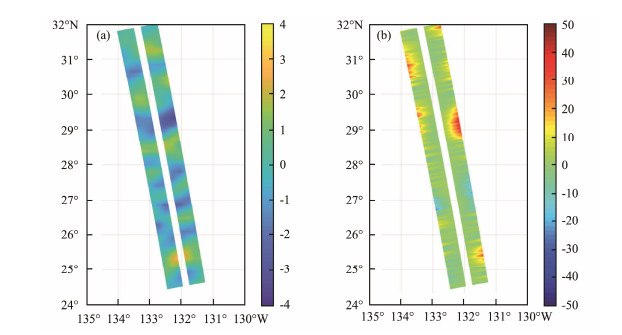
|
Fig. 11 (a), corrected sea surface height (unit: m); (b), residual error (unit: cm). |
The steps in Section 3.1 were executed on Sentinel-3B, CryoSat-2, Saral, and Jason-3. The results are shown in Table 2 and Fig.12.
|
|
Table 2 Statistical results of baseline error estimation based on each nadir altimeter after along-track treatment |
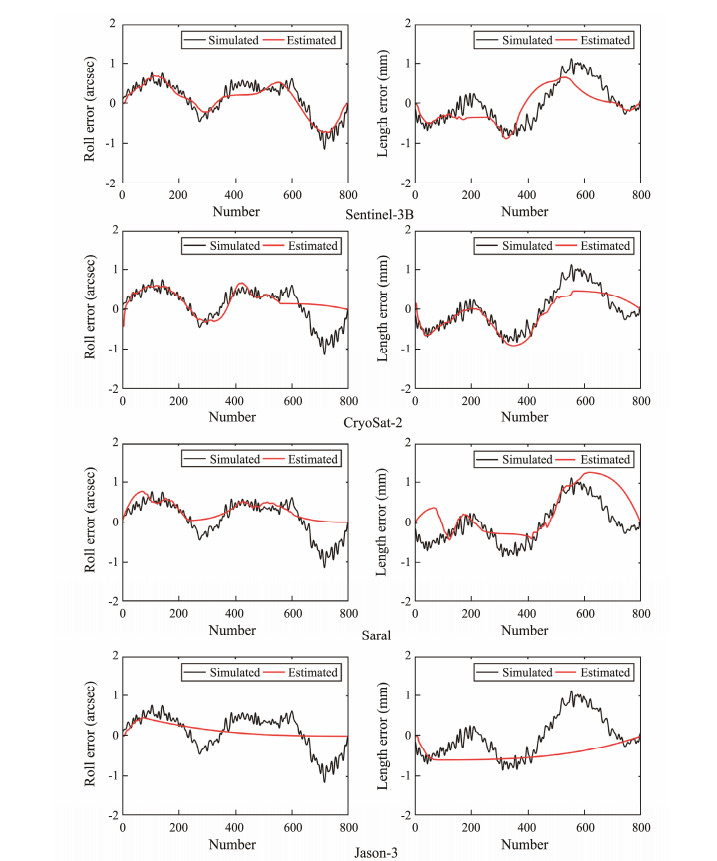
|
Fig. 12 Simulated and estimated values of roll error (left) and length error (right). |
Fig.12 and Table 2 indicate that the baseline error estimates based on Sentinel-3B and CryoSat-2 can have some effect, but the results are slightly worse than those of Sentinel-3A. The baseline error estimate results based on Saral and Jason-3 are poor, possibly due to the limited crossover points of these nadir and wide-swath altimeters. Compared with the observation swath of tens or even hundreds of kilometers, the orbital spacing of the nadir altimeter is excessively sparse. The RMSE of sea surface height after correction depends on the estimation results of roll and length errors, which is associated with the proportion of measurement lines with two or more crossover points in the entire region, namely the coverage in Table 2. The distribution of crossover points depends on satellite orbital parameters, which means that the coverage between nadir and wide-swath altimeters is fixed for a particular nadir altimeter. Therefore, using multiple nadir altimeter constellations to improve the estimation effect is considered.
3.3 Estimation Results Based on Multi-Nadir Altimeter ConstellationsOne nadir altimeter could be used in this study to estimate the baseline error of a wide-swath altimeter, but the performance was neither high nor stable. Therefore, a multi-nadir altimeter constellation was used to solve this problem. Three constellation combination schemes, namely Sentinel-3A + Sentinel-3B (referred to as S3AB), CryoSat- 2 + Saral + Jason-3 (referred to as CSJ), and all five nadir altimeters (referred to as FiveNadirs), are considered in this section according to the orbital characteristics of nadir altimeters.
First, the simulated sea surface height data of each nadir altimeter obtained above are grouped into different constellation datasets. The method described in Section 3.1 is used to estimate the baseline error for each constellation. The results are shown in Fig.13 and Table 3.
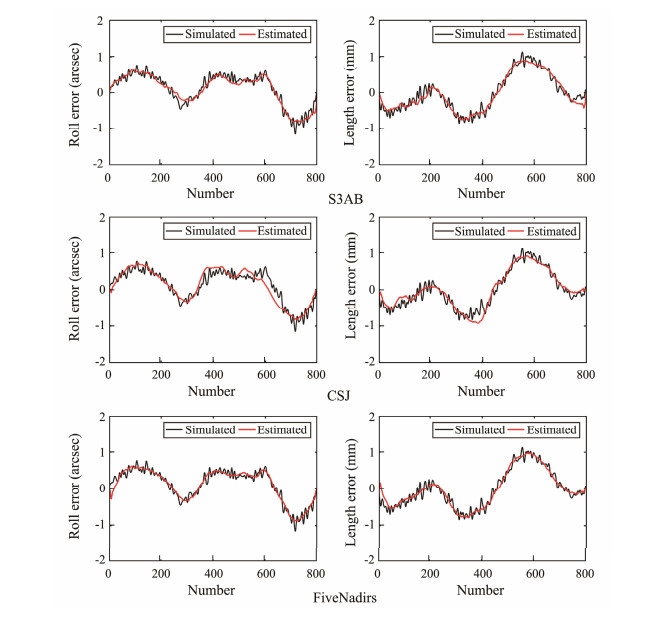
|
Fig. 13 Simulated and estimated values of roll error (left) and length error (right). |
|
|
Table 3 Statistical results of the baseline error estimation based on each constellation after along-track treatment |
Fig.13 and Table 3 reveal that the use of multiple nadir altimeters for baseline error estimation can help improve the estimation results. The first two combinations cover the entire observation swath region and accurately describe the trend of the baseline change. However, some miscalculations may be observed in a few situations. The simultaneous use of five nadir altimeters can almost completely describe the baseline error.
The sea surface height error was calculated and corrected over the entire observation swath region according to Eqs. (3) and (4) using the estimated roll and length errors based on five nadir altimeters. The corrected sea surface height and residual error imaging are shown in Fig.14.
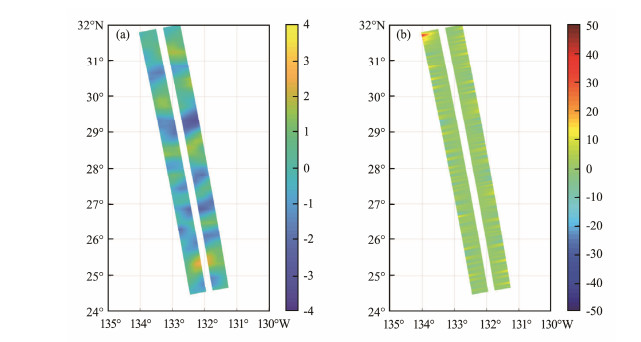
|
Fig. 14 (a), corrected sea surface height using a five nadir altimeter constellation (unit: m); (b), residual error (unit: cm). |
Fig.14(b) shows that the sea surface height error is significantly reduced by using five nadir altimeters. The statistical results show that the total RMSE of height can be reduced to 2.88 cm. However, this method still cannot obtain the high-frequency variation in the baseline error due to the smooth noise reduction operation. Compared with some previous studies, the largest advantage of this approach lies in its execution in the presence of roll and length errors and its excellent performance without assuming that only one of the errors exists.
4 DiscussionThe above experiments assumed that the errors other than the baseline error had been ideally corrected, leaving several residual errors with Gaussian distributions. However, from a realistic perspective, another source of error should be considered, that is, the error related to the sea state. Some studies have shown that dynamic changes in sea surface waves can cause electromagnetic bias as well as phenomena, such as volumetric decorrelation, wave spectrum aliasing, velocity bunching, and surfboard sampling, which affect the performance of wide-swath altimeters (Peral et al., 2015; Bai et al., 2020). The main factors influencing these effects include the significant wave height (SWH), incident angle, and relative wave direction, among which the SWH occupies a dominant position. The WAVEWATCH-III simulation research by Peral et al. (2015) indicated that the swath-average height error caused by multiple wave effects is 2.4 and 2.9 cm when the SWH is 2 and 4 m, respectively, which significantly increases to 6.4 cm when the SWH increases to 8 m. The height error provided herein is the original error caused by waves, not the remaining part after ideal correction.
The extent of disturbance of the previously performed baseline error estimation method as the sea state increases will be discussed in this section. The same sea surface to be measured and the baseline error introduced will remain constant to maintain the continuity and comparability of the above experiments. The wave-related error is merged with the random Gaussian error within the swath, that is, εswath in Eq. (5), which represents the total residual error after ideal correction, except for the baseline error. The standard deviation of this part of the Gaussian error ranges from 0.5 cm to 5 cm, which can cover the different wave errors based on SWHs ranging from 2 m to 8 m under normal to extreme conditions.
The baseline error estimation and correction were conducted using the same five nadir altimeter constellation, and the results are shown in Fig.15. The black line represents the total sea surface height RMSE before baseline error correction, and the red line is after correction.
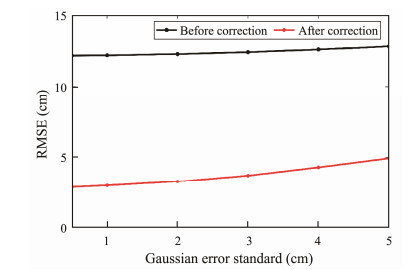
|
Fig. 15 Sea surface height RMSE before and after baseline error correction under different sea conditions. |
The total sea surface height RMSE rises slowly from 12.18 cm to 12.82 cm when the Gaussian error standard deviation increases ten times. This result indicates that the total height error does not change significantly with the sea state due to the dominance of the baseline error. By contrast, the residual height error RMSE after correction changes from 2.88 cm to 4.92 cm. However, the data results indicate that all the correlation coefficients between the estimated roll error and the simulated value are 0.97 under varying degrees of random Gaussian error, which is also the case for the length error. The RMSE of the roll error is maintained at 0.11 arcsec, and that of the length error is approximately 0.12 mm. This result demonstrates that the baseline error has been accurately estimated under various sea states. The increase in the total height RMSE after baseline correction is mainly caused by wave-related errors, and the correction effect of the baseline error has minimal influence; that is, this baseline error estimation method has good stability.
5 ConclusionsRoll and length errors are important error sources in wide-swath altimeter measurements, resulting in large height errors, especially outside the observation swath. Both error sources have a strong correlation with the cross-track distance, but their spatial correspondences are different. A WSRA simulation system is developed in the current study to demonstrate the influence of the baseline error on the measurement of the wide-swath altimeter. The height error caused by the baseline error is unevenly distributed in the swath; therefore, the simple adjustment method, which averages the measurement result of the ascending and descending paths to reduce the height error, cannot be used.
The residual height error for a wide-swath altimeter should be primarily dependent on the roll and length errors after the ideal correction of other weakly cross-track-dependent error sources. The methodology that estimates the baseline error of a wide-swath altimeter by using nadir altimeters is studied on the basis of the relationship between the baseline error and the cross-track distance. The coordinates of the wide-swath and nadir altimeters in the target region are matched, and their respective measured values at the precise crossover points are obtained by interpolation to calculate the sea surface height difference. The estimated values of the roll and length errors are obtained simultaneously using the least-squares fitting method according to the cross-track distance. Finally, the baseline error estimation results of the entire area are obtained through along-track data processing, and these values are used for height error correction of the wide-swath altimeter.
The data results reveal that the correlation coefficient between the estimated and simulated values is 0.89 and 0.85 for the roll and length errors when only Sentinel-3A is used as a simulated reference data source for the SWOT simulated data, and the RMSE of height can be reduced from 12.18 cm to 6.45 cm in this experiment. Furthermore, the test results of other single nadir altimeters indicate that the estimation effect of the wide-swath altimeter baseline error has a connection with the coverage ratio, in which the measurement lines exceed two or more crossover points in the entire area.
Analysis shows that increasing the number of crossover points of the nadir and wide-swath altimeters can improve the baseline error estimation effect. However, the position of the intersection of a single nadir altimeter and a wide-swath altimeter is fixed by their orbital parameters. This phenomenon suggests that multiple nadir altimeters can be used to form a constellation to estimate the baseline error of a wide-swath altimeter. The results also show that the RMSE of the sea surface height can be further reduced to 2.88 cm by the same method when Sentinel-3A, Sentinel-3B, CryoSat-2, Saral, and Jason-3 are combined. In addition, different sea states will affect the measurement accuracy of a wide-swath altimeter by introducing additional errors. A supplementary experiment was conducted to assess the performance of this baseline error correction method with different degrees of other errors. The simulation results are promising because the baseline error estimation method is unaffected by sea states; that is, it has good stability.
Compared with some previous studies, this method can be performed in the presence of roll and length errors, without presuming that only one of these errors exists. Capturing the high-frequency error is still difficult due to the spatial resolution limit of nadir altimeters. However, this method achieved satisfactory results in simulation experiments. This method can also provide an optional methodology for baseline error estimation and correction for future SWOT or other wide-swath altimeters.
AcknowledgementsThis work was supported by the Shandong Provincial Natural Science Foundation (No. ZR2020MD097), the National Key Research and Development Program of China (No. 2016YFC1401004), and the National Natural Science Foundation of China (No. 62031005).
Bai, Y., Wang, Y., Zhang, Y., Zhao, C., and Chen, G.. 2020. Impact of ocean waves on Guanlan's IRA measurement error. Remote Sensing, 12(10): 1534. DOI:10.3390/rs12101534 (  0) 0) |
Bosch, W., Dettmering, D., and Schwatke, C.. 2014. Multi-mission cross-calibration of satellite altimeters: Constructing a long-term data record for global and regional sea level change studies. Remote Sensing, 6(3): 2255-2281. DOI:10.3390/rs6032255 (  0) 0) |
Cazenave, A., Palanisamy, H., and Ablain, M.. 2018. Contemporary sea level changes from satellite altimetry: What have we learned? What are the new challenges?. Advances in Space Research, 62(7): 1639-1653. DOI:10.1016/j.asr.2018.07.017 |
Desai, S., 2018. Surface Water and Ocean Topography Mission (SWOT): Science requirements document, NASA (accessed 24 January 2018, Rev B), 1-28. Available online: https://swot.jpl.nasa.gov/files/swot/ (accessed on 31 December, 2021).
(  0) 0) |
Dibarboure, G., and Ubelmann, C.. 2014. Investigating the performance of four empirical cross-calibration methods for the proposed SWOT mission. Remote Sensing, 6: 4831-4869. DOI:10.3390/rs6064831 (  0) 0) |
Dibarboure, G., Labroue, S., Ablain, M., Fjortoft, R., Mallet, A., Lambin, J., et al.. 2012. Empirical cross-calibration of coherent SWOT errors using external references and the altimetry constellation. IEEE Transactions on Geoscience and Remote Sensing, 50(6): 2325-2344. DOI:10.1109/TGRS.2011.2171976 (  0) 0) |
Du, Y., Yang, S., and Shi, H., 2010. Study on accurate estimation of baseline parameters of space-borne InSAR based on GCPs. 18th International Conference on Geoinformatics. Beijing, 1-4.
(  0) 0) |
Durand, M., Fu, L. L., Lettenmaier, D. P., Alsdorf, D. E., Rodriguez, E., and Esteban-Fernandez, D.. 2010. The surface water and ocean topography mission: Observing terrestrial surface water and oceanic submesoscale eddies. Proceedings of the IEEE, 98(5): 766-779. DOI:10.1109/JPROC.2010.2043031 (  0) 0) |
Esteban-Fernandez, D., Rodriguez, E., Fu, L. L., Alsdorf, D., and Vaze, P., 2010. The surface water and ocean topography mission: Centimetric spaceborne radar interferometry. Proceedings of SPIE - Conference on Sensors, Systems, and Next-Generation Satellites XIV. Toubouse, 455-461.
(  0) 0) |
Fu, L. L., and Rodriguez, E., 2004. High-resolution measurement of ocean surface topography by radar interferometry for oceanographic and geophysical applications. In: The State of the Planet: Frontiers and Challenges in Geophysics. Sparks, R. S. J., and Hawkeswort, C. J., eds., American Geophysical Union, Washington D. C., 209-224.
(  0) 0) |
Fu, L. L., and Ubelmann, C.. 2014. On the transition from profile altimeter to swath altimeter for observing global ocean surface topography. Journal of Atmospheric and Oceanic Technology, 31(2): 560-568. DOI:10.1175/JTECH-D-13-00109.1 (  0) 0) |
Gaultier, L., Ubelmann, C., and Fu, L. L.. 2016. The challenge of using future SWOT data for oceanic field reconstruction. Journal of Atmospheric and Oceanic Technology, 33(1): 119-126. DOI:10.1175/JTECH-D-15-0160.1 (  0) 0) |
Hamlington, B. D., Leben, R. R., and Kim, K. Y.. 2012. Improving sea level reconstructions using non-sea level measurements. Journal of Geophysical Research, 117(C10): 1-14. (  0) 0) |
Metref, S., Cosme, E., Le Sommer, J., Poel, N., Brankart, J. M., Verron, J., et al.. 2019. Reduction of spatially structured errors in wide-swath altimetric satellite data using data assimilation. Remote Sensing, 11: 1336. DOI:10.3390/rs11111336 (  0) 0) |
Peral, E., and Esteban-Fernandez, D., 2018. SWOT mission performance and error budget. Proceedings of the IGARSS 2018 - 2018 IEEE International Geoscience and Remote Sensing Symposium. Valencia, 8625-8628.
(  0) 0) |
Peral, E., Rodríguez, E., and Esteban-Fernández, D.. 2015. Impact of surface waves on SWOT's projected ocean accuracy. Remote Sensing, 7(11): 14509-14529. DOI:10.3390/rs71114509 (  0) 0) |
Quartly, G., Nencioli, F., Labroue, S., Femenias, P., and Cretaux, J. F., 2017. Ensuring that the Sentinel-3A altimeter provides climate-quality data. Conference on Remote Sensing of the Ocean, Sea Ice, Coastal Waters, and Large Water Regions 2017. Warsaw, 104220R.
(  0) 0) |
Ren, L., Yang, J., Dong, X., Zhang, Y., and Jia, Y.. 2020. Preliminary evaluation and correction of sea surface height from Chinese Tiangong-2 interferometric imaging radar altimeter. Remote Sensing, 12(15): 2496. DOI:10.3390/rs12152496 (  0) 0) |
Rodriguez, E., and Esteban-Fernandez, D., 2010. The Surface Water and Ocean Topography Mission (SWOT): The Ka-band Radar Interferometer (KaRIn) for water level measurements at all scales. Proceedings of SPIE - Conference on Sensors, Systems, and Next-Generation Satellites XIV. Toulouse, 782614.
(  0) 0) |
Salameh, E., Frappart, F., Marieu, V., Spodar, A., Parisot, J. P., Hanquiez, V., et al.. 2018. Monitoring sea level and topography of coastal lagoons using satellite radar altimetry: The example of the Arcachon Bay in the Bay of Biscay. Remote Sensing, 10(2): 1-22. (  0) 0) |
Ubelmann, C., Dibarboure, G., and Dubois, P.. 2018. A crossspectral approach to measure the error budget of the SWOT altimetry mission over the ocean. Journal of Atmospheric and Oceanic Technology, 35(4): 845-857. DOI:10.1175/JTECH-D-17-0061.1 (  0) 0) |
Wang, J., and Fu, L. L.. 2019. On the long-wavelength validation of the SWOT KaRIn measurement. Journal of Atmospheric and Oceanic Technology, 36(5): 843-848. DOI:10.1175/JTECH-D-18-0148.1 (  0) 0) |
Wang, J., Fu, L. L., Qiu, B., Menemenlis, D., Farrar, J. T., Chao, Y., et al.. 2018. An observing system simulation experiment for the calibration and validation of the surface water ocean topography sea surface height measurement using in situ platforms. Journal of Atmospheric and Oceanic Technology, 35(2): 281-297. DOI:10.1175/JTECH-D-17-0076.1 (  0) 0) |
Wang, J., Fu, L. L., Torres, H. S., Chen, S., Qiu, B., and Menemenlis, D.. 2019. On the spatial scales to be resolved by the surface water and ocean topography Ka-band radar interferometer. Journal of Atmospheric and Oceanic Technology, 36(1): 87-99. DOI:10.1175/JTECH-D-18-0119.1 (  0) 0) |
Yang, J., Zhang, J., and Wang, C.. 2019. Sentinel-3A SRAL global statistical assessment and cross-calibration with Jason-3. Remote Sensing, 11(13): 1573. DOI:10.3390/rs11131573 (  0) 0) |
Zhang, Y., Zhai, W., Gu, X., Shi, X., and Kang, X., 2014. Experimental demonstration for the attitude measurement capability of interferometric radar altimeter. 15th International Radar Symposium (IRS). Gdansk, 1-4.
(  0) 0) |
Zhai, W., Zhang, Y., Shi, X., Dong, X., and Kang, X., 2019. A new method for estimation of baseline incline angle for doubleside looking interferometric imaging radar altimeter. Proceedings of the 2019 PhotonIcs & Electromagnetics Research Symposium-Spring (PIERS-Spring). Rome, 2112-2115.
(  0) 0) |
 2022, Vol. 21
2022, Vol. 21


